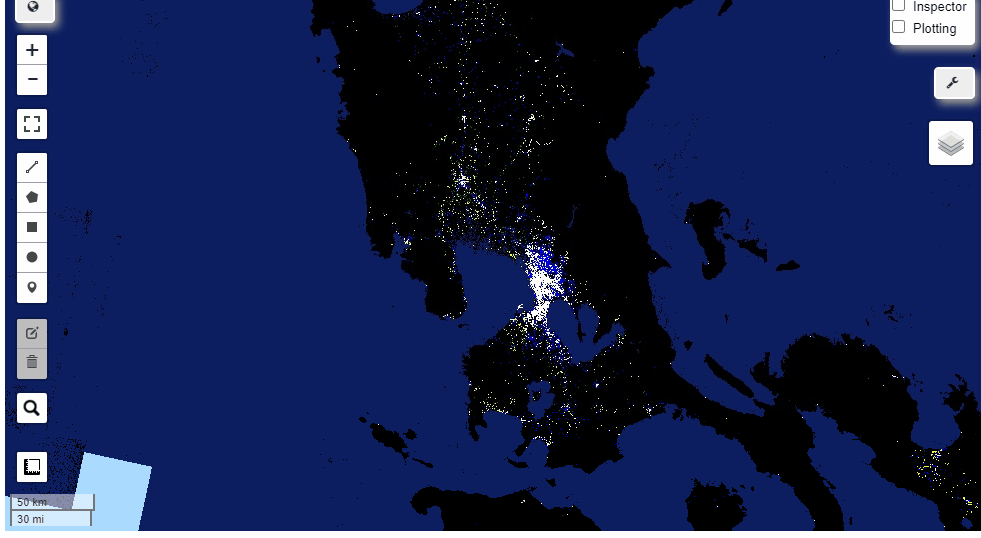圖像特征 可視化
地理可視化/菲律賓/遙感 (GEOVISUALIZATION / PHILIPPINES / REMOTE-SENSING)
Big data is incredible! The way Big Data manages to bring sciences and business domains to new levels is almost sort of magical. It allows us to tap into a variety of avenues to access the information we normally do not access in order to gain fresh insights.
大數據令人難以置信! 大數據設法將科學和商業領域提升到新的水平幾乎是一種神奇的方法。 它使我們能夠利用各種途徑來訪問我們通常不訪問的信息,以獲得新的見解。
Satellite images are an amazing unconventional source to tap into for these fresh insights. Urban planners, environmentalists, and geospatial data scientists usually turn to satellite images for a big picture perspective and find insights from this exercise that brings their intended solutions to a whole new level.
衛星圖像是令人驚嘆的非常規資源,可用于獲取這些新見解。 城市規劃人員,環境保護主義者和地理空間數據科學家通常將衛星圖像用于全局視角,并從此練習中找到見解,從而將其預期的解決方案提高到一個全新的水平。
Crash Course in Satellite Image Analysis a.k.a. Remote Sensing
衛星圖像分析又名遙感速成班
If you ever came across the term “remote-sensing” in online articles, more likely this refers to the process of observing the earth using satellites. They’re called as such because they have the ability to make measurements remotely.
如果您在在線文章中遇到過“遙感”一詞,則更可能是指使用衛星觀測地球的過程。 之所以這樣稱呼它們是因為它們具有遠程進行測量的能力。
What do these remote-sensing instruments sense? The short answer is radiation. To be more technical, these instruments sense electromagnetic radiation.
這些遙感儀器有什么意義? 簡短的答案是輻射。 從技術上講,這些儀器可感應電磁輻射。
These electromagnetic radiations vary in wavelength and frequencies and along this spectrum, there is a tiny portion our eyes can see known as the “visible spectrum”.
這些電磁輻射的波長和頻率各不相同,并且沿著該光譜,我們的眼睛可以看到的一小部分稱為“可見光譜”。

This is where satellites come into play. Satellites that are orbiting the earth have lenses that can not only detect visible light but infrared wavelengths (nearest one to the visible spectrum) and microwaves.
這就是衛星發揮作用的地方。 環繞地球運行的衛星具有不僅可以檢測可見光,而且可以檢測紅外波長( 最接近可見光譜的波長 )和微波的透鏡。
When the light coming from the sun reaches the surface of the earth, every object reflects, absorbs, or transmits this energy differently. For example, green plants absorb all colors but reflect the green color. This is why green is the one visible to us when looking at plants. In some cases, the same type of plant may not be equally hydrated, and while this tiny difference will not be seen by the naked eye, the way these two plants reflect light will be different.
當來自太陽的光到達地球表面時,每個物體都會以不同的方式反射,吸收或傳輸該能量。 例如,綠色植物吸收所有顏色但反射綠色。 這就是為什么綠色是我們看植物時可見的一種原因。 在某些情況下,同一種植物的水合程度可能不同,雖然肉眼看不到這種微小差異,但兩種植物反射光的方式卻有所不同。
And as you know it, not all light reflected is visible.
如您所知,并不是所有反射的光都是可見的。
Because surfaces reflect light differently, satellites have been used in studying vegetation, flood-prone areas and even analyzing the built-up areas of a place across the years.
由于表面反射光線的方式不同,多年來,人造衛星已用于研究植被,易發生洪水的地區,甚至分析某個地方的建筑面積。
While anyone can go and look up and download satellite images, they may not contain the data coming from the reflection which produces so many insights at once.
盡管任何人都可以查找并下載衛星圖像,但它們可能不包含來自反射的數據,而反射會立即產生很多洞察力。
This is the data that we’re after. In the visualization that we will be doing later, the difference in color represents the difference in radiation being reflected. Since this is a multitemporal visualization (multiple time periods), the colors will represent surface of the built-up area across different time series for a place.
這是我們需要的數據。 在我們稍后將要進行的可視化中,顏色的差異表示所反射的輻射的差異。 由于這是一個多時間可視化( 多個時間段 ),因此顏色將代表一個地點在不同時間序列上的建筑區域的表面。
Preliminaries
初賽
To continue with this tutorial, make sure the following is done first:
要繼續本教程,請確保首先完成以下操作:
Create an account with Google Earth Engine. This is free and will be authenticated in your Jupyter Notebook.
使用Google Earth Engine創建一個帳戶。 這是免費的,將在您的Jupyter Notebook中進行身份驗證。
Install Google Maps (pip install geemap) and Earth Engine (pip install ee).
安裝Google Maps(pip install geemap )和Earth Engine(pip install ee )。
- Initialize earth engine using ee.Initialize() 使用ee.Initialize()初始化地球引擎
Dataset
數據集
For this exercise, we will access the “GHSL: Global Human Settlement Layers” dataset from the Google Earth Engine database.
在本練習中,我們將從Google Earth Engine數據庫訪問“ GHSL:全球人類住區圖層”數據集。
The Global Human Settlement (GHS) framework produces global spatial information about the human presence on the planet over time. This includes physical settlement so this captures built-up area over time.
全球人類住區 (GHS)框架會隨著時間的推移生成有關地球上人類活動的全球空間信息。 這包括物理沉降,以便隨著時間的推移捕獲建筑面積。
Let’s Code!
讓我們編碼!
#Preliminaries
import geemap
import ee#After importing, it is important to initialize this.
ee.Initialize()Initalize the folium map:
初始化大葉貼圖:
Map = geemap.Map(center=[15.222871,120.574440], zoom=7)
Map
Load the dataset and store it as an object.
加載數據集并將其存儲為對象。
#Note that ee.Image and ee.ImageCollection can both access datasets but you need to check which one is applicable for your intended datasetimage = ee.Image('JRC/GHSL/P2016/BUILT_LDSMT_GLOBE_V1')Select “built” band as we want the built-up area.
選擇“內置”頻段,因為我們需要內置區域。
builtUp = image.select('built')Define the Vis Parameters.
定義可見參數。
visParams = {
'min': 1.0,
'max': 6.0,
'palette': ['0c1d60', '000000', '448564', '70daa4', '83ffbf', 'ffffff'],
}For this to make sense, let’s refer to what these min and max refer to:
為了使這有意義,讓我們參考這些最小和最大所指:

The min and max refer to the value column in the built Class Table above. For best viewing, you should choose min=1 and max=6. You do not want to leave out the water and land values as your visualization may not have a legible form for some readers that are not experts in reading maps.
最小值和最大值是指上面構建的類表中的value列。 為了獲得最佳觀看效果,您應該選擇min = 1和max = 6。 您不希望遺漏水和土地的價值,因為對于某些不是閱讀地圖專家的讀者來說,可視化可能沒有清晰的形式。
The palette simply assigns a color to the class value. The suggested colors are seen in the built Class table. You can use hex codes but leave the “#’ out.
調色板只是將顏色分配給類值。 建議的顏色顯示在內置的“類”表中。 您可以使用十六進制代碼,但不要使用“#”。
#.addLayer method adds this on top of your initialized Map above
Map.addLayer(builtUp, visParams, 'Built-Up Multitemporal')This is how it will appear for the suggested colors.
這就是建議顏色的顯示方式。


Alternatively, you can use color names directly for the palette. Make sure to arrange it so the first color matches Value 1 for the built Class table.
或者,您可以直接將顏色名稱用于調色板。 確保對其進行排列,以使第一種顏色與構建的Class表的Value 1相匹配。
visParams = {
'min': 1.0,
'max': 6.0,
'palette': ['0c1d60', 'black', 'yellow', 'green', 'blue', 'white'],
}Notice you can use the inspector function to check the value of a point:
注意,您可以使用檢查器功能檢查點的值:

So from this exercise, you can see that most built-up areas are found on the capital of the Philippines and areas near it like Region III and Region IV-A. And you can likewise trace a pattern and answer the question “Where does development occur for a particular period?”.
因此,通過此練習,您可以看到在菲律賓首都及其附近地區,如第三區和第四區-A區,發現了大多數建成區。 同樣,您可以跟蹤模式并回答“在特定時期內哪里發生發展?”的問題。
There are other modifications that we can do for this such as limiting the visualization to simply one city or province.
我們可以為此進行其他修改,例如將可視化范圍限制為一個城市或省份。
With Google Earth Engine, you can access other datasets as well.
使用Google Earth Engine,您還可以訪問其他數據集。
Feel free to explore the other datasets. Happy coding!
隨意探索其他數據集。 編碼愉快!
Click here to view the Jupyter Notebook for this one on Github.
單擊此處 ,在Github上查看此書的Jupyter筆記本。
翻譯自: https://towardsdatascience.com/visualizing-built-up-areas-using-satellite-images-18d43f34f0b3
圖像特征 可視化
本文來自互聯網用戶投稿,該文觀點僅代表作者本人,不代表本站立場。本站僅提供信息存儲空間服務,不擁有所有權,不承擔相關法律責任。 如若轉載,請注明出處:http://www.pswp.cn/news/389807.shtml 繁體地址,請注明出處:http://hk.pswp.cn/news/389807.shtml 英文地址,請注明出處:http://en.pswp.cn/news/389807.shtml
如若內容造成侵權/違法違規/事實不符,請聯系多彩編程網進行投訴反饋email:809451989@qq.com,一經查實,立即刪除!





)




)
)



)


